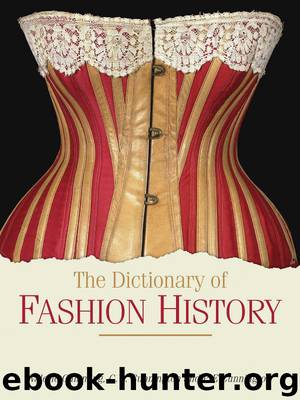The Dictionary of Fashion History by Valerie Cumming

Author:Valerie Cumming
Language: eng
Format: epub
ISBN: 9781847887382
Publisher: Berg Publishers
Published: 2010-09-01T04:00:00+00:00
* * *
O
* * *
Oatland village hat
(F)
Period: 1800.
A day hat, the brim curved up in front and behind, the crown dome-shaped with a ribbon round it. Of straw, twist or leghorn. Named after the country house of the Duchess of York.
Obi
Period: Late 19th century onwards.
A long sash worn around the waist to secure a garment in Japan, e.g. a kimono. The style became well known in the west in the 19th century and was referenced by 20th-century fashion designers.
Obi hat
(F)
Period: 1804.
A straw or chip hat for walking; the high crown with flat top, a narrow brim rolled back in front; tied under the chin with ribbon strings passing over the brim from the crown which was also trimmed round with ribbon. Named after a character in a pantomime.
Oblong hoop, square hoop
(F)
Period: 1740s–1760s.
An undergarment variously constructed, projecting out horizontally from the waist on each side, the front and back being flattened to give enormous breadth to the hips. Some were hinged, allowing the wearer to fold the overskirt under the arms when passing through a too-narrow doorway. It was required for court dress and in a modified form continued until 1820.
Octagon tie
(M)
Period: 1860s to early 20th century.
A made-up scarf, the front arranged in four tabs above the tie-pin with a neck-band fastened behind by a hook and eyelet hole.
Oes, owes
(F, rarely M)
Period: 16th and 17th centuries.
Small rings or eyelets sewn to the material of a garment to form decorative designs. “Vaile of net lawne embroidered with Oes” (1616, Chapman, Masque of the Inns of Court).
See Spangles.
Off-the-peg
(F & M)
Period: 1850 onwards.
Clothing that could be bought from shop stock rather than being made-to-measure. Often carried connotations of being cheap and nasty in terms of fabric and fit until the 20th century.
Off-the-shoulder
(F)
Period: 20th century onwards.
A style of neckline which leaves the neck, shoulders and upper arms uncovered; often used for formal evening dresses.
Oilets
Period: 18th and early 19th centuries.
The early term for eyelets or lacing holes.
Oker, hogger, hoker, coker
(M)
Period: 16th century.
“Boots for ploughmen called Okers” (1552, Hulcot).
Oldenburg bonnet
(F)
Period: 1814.
A very large bonnet with wide, projecting brim in front and a flat crown draped with ostrich feathers; ribbon ties under the chin. Named after the Duchess of Oldenburg, sister of Tsar Alexander I and, with him, a visitor to the Peace celebrations of 1814.
Olive button
Period: Mid-18th century onwards.
A long, oval button covered with silk.
Olivet, olivette
Period: Mid-18th century onwards.
An olive-shaped button of wood covered with silk or braid and used to fasten a brandenburg.
See Frog-button.
Ondina crinoline
(F)
Period: 1860s.
A cage crinoline with the hoops arranged in “wave-like bands”.
Op Art
Period: Mid-1960s onwards.
A movement which used bold, abstract designs, often in strongly contrasting colours such as black and white. It had a considerable impact on fabric design and clothing in the late 1960s and in subsequent revivals ca. 2000.
Open robe
(F)
Period: 19th century.
A style of dress in which the skirt is open in front from the waist down, revealing a decorative underskirt or petticoat. It was chiefly fashionable, for day and evening, during the 1830s and 1840s.
Although this form of construction was
Download
This site does not store any files on its server. We only index and link to content provided by other sites. Please contact the content providers to delete copyright contents if any and email us, we'll remove relevant links or contents immediately.
Wonder by R.J. Palacio(8446)
Mastering Adobe Animate 2023 - Third Edition by Joseph Labrecque(3758)
Unlabel: Selling You Without Selling Out by Marc Ecko(3587)
Ogilvy on Advertising by David Ogilvy(3503)
Hidden Persuasion: 33 psychological influence techniques in advertising by Marc Andrews & Matthijs van Leeuwen & Rick van Baaren(3472)
Drawing Cutting Edge Anatomy by Christopher Hart(3453)
The Pixar Touch by David A. Price(3362)
POP by Steven Heller(3307)
The Code Book by Simon Singh(3073)
The Art of War Visualized by Jessica Hagy(2943)
Slugfest by Reed Tucker(2937)
The Curated Closet by Anuschka Rees(2911)
Rapid Viz: A New Method for the Rapid Visualization of Ideas by Kurt Hanks & Larry Belliston(2832)
Stacked Decks by The Rotenberg Collection(2810)
365 Days of Wonder by R.J. Palacio(2751)
The Wardrobe Wakeup by Lois Joy Johnson(2731)
Keep Going by Austin Kleon(2696)
Tattoo Art by Doralba Picerno(2599)
Tell Me More by Kelly Corrigan(2591)
